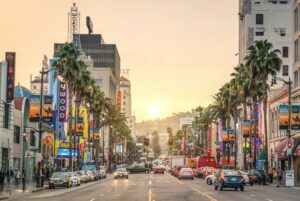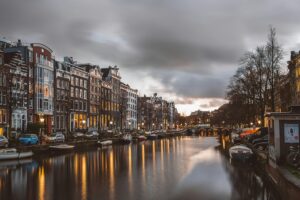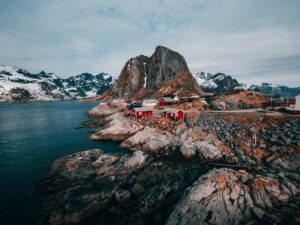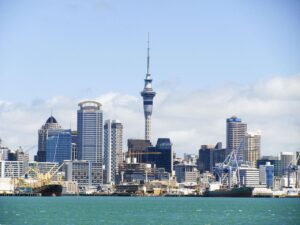Dubai. The name alone conjures images of impossibly tall skyscrapers piercing desert skies, golden sand dunes meeting turquoise waters, and a city where the future feels like the present. This futuristic desert metropolis stands as a testament to human ambition, seamlessly blending cutting-edge innovation with rich Emirati tradition in ways that continue to captivate millions of visitors each year.
If you’re searching for the top 10 places to visit in Dubai, you’ve come to the right place. This comprehensive guide covers everything from iconic architectural marvels and historic cultural districts to family-friendly attractions and luxury experiences that define this extraordinary city. Whether you’re a first-time visitor planning your maiden voyage or a returning traveler seeking new adventures, the top 10 best places to visit in Dubai outlined here will help you craft an unforgettable itinerary.
For official tourism information and the latest updates, visit Visit Dubai, the official tourism portal managed by the Dubai Department of Economy and Tourism.
Dubai’s transformation from a modest pearl-diving village in the early 20th century to one of the world’s most dynamic global hubs is nothing short of remarkable. Today, it stands as the commercial and cultural heart of the United Arab Emirates, where ancient souks exist alongside ultra-modern shopping districts, and traditional dhow boats share waterways with luxury yachts. The top 10 fun places to visit in Dubai showcase this unique duality, offering something for everyone: adrenaline junkies, culture enthusiasts, luxury seekers, and families alike.
TL;DR: Quick Overview
Here are the top 10 places to see in Dubai at a glance:
- Burj Khalifa – The world’s tallest building offering breathtaking city views
- The Dubai Mall – A shopping and entertainment paradise with over 1,200 stores
- Palm Jumeirah – The iconic palm-shaped artificial island dotted with luxury resorts
- Dubai Marina – A sleek waterfront neighborhood buzzing with yachts and nightlife
- Al Fahidi Historical District – The soul of old Dubai with traditional wind-tower architecture
- Dubai Creek – The historic heart where traditional souks meet modern promenades
- Jumeirah Mosque & Beach – Stunning Islamic architecture meets pristine coastline
- Desert Safari – Dune bashing, camel rides, and authentic Bedouin experiences
- Dubai Miracle Garden – The world’s largest natural flower garden featuring spectacular displays
- Global Village – A multicultural festival bringing the world’s cultures to one location
1. Burj Khalifa
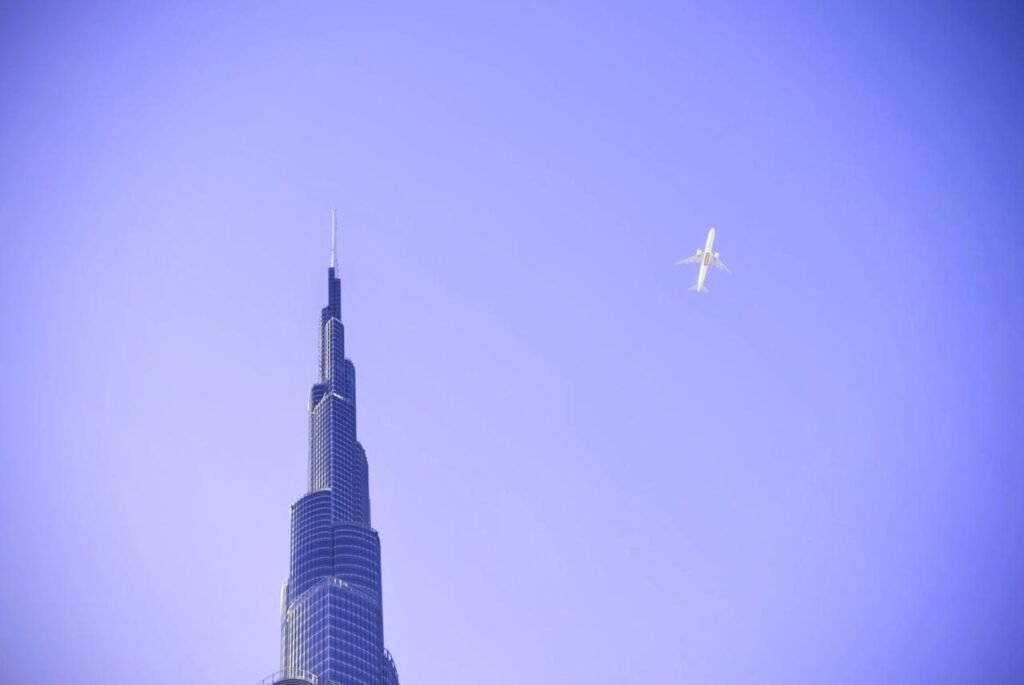
Why Visit
Standing at an astounding 828 meters (2,717 feet), the Burj Khalifa isn’t just the world’s tallest building. It’s a symbol of Dubai’s audacious vision and limitless ambition. This architectural marvel dominates the Dubai skyline like a gleaming needle threading earth to sky, and visiting it is absolutely essential for anyone experiencing Dubai for the first time.
Highlights
At The Top Observation Decks: The primary viewing platforms are located on the 124th and 125th floors, offering 360-degree views of the sprawling city below. For an even more exclusive experience, upgrade to the At The Top SKY on the 148th floor, the highest observation deck in the world at 555 meters. You can book tickets in advance on the official website.
From these dizzying heights, you’ll witness:
- The geometric perfection of Palm Jumeirah stretching into the Arabian Gulf
- The endless expanse of the Arabian Desert meeting urban development
- The intricate network of Sheikh Zayed Road cutting through the city
- The dancing waters of the Dubai Fountain choreographed far below
Armani Hotel: Occupying floors 1 through 8 and 38 through 39, this hotel designed by Giorgio Armani himself offers the ultimate in luxury accommodation within the tower.
The Dubai Fountain: Located at the base of Burj Khalifa, this choreographed fountain system shoots water up to 500 feet in the air, set to music ranging from classical to contemporary Arabic and world music. Shows run every 30 minutes in the evening, and it’s completely free to watch.
Best Time to Visit
Sunset hours (approximately 5:00 PM to 7:00 PM) offer the best of both worlds. You’ll see Dubai bathed in golden afternoon light, then watch as the city transforms into a glittering sea of lights as dusk falls. Book your tickets well in advance for these prime time slots, as they sell out quickly.
Early morning visits (8:00 AM to 10:00 AM) provide crystal-clear visibility and smaller crowds, ideal for photography enthusiasts.
How to Get There
Nearest Metro Station: Burj Khalifa/Dubai Mall Station (Red Line)
The station connects directly to the Dubai Mall, from where you’ll follow clearly marked signs to the Burj Khalifa entrance. The walk takes approximately 5-10 minutes through air-conditioned corridors.
Pro Tips
- Book tickets online in advance to save up to 30% compared to walk-in prices
- Avoid visiting during sandstorms or hazy days, as visibility will be severely limited
- The tower’s exterior LED lights create stunning displays after dark
- Combine your visit with a Dubai Fountain show for maximum impact
- Consider the “At The Top Sunrise” experience for truly magical moments
2. The Dubai Mall
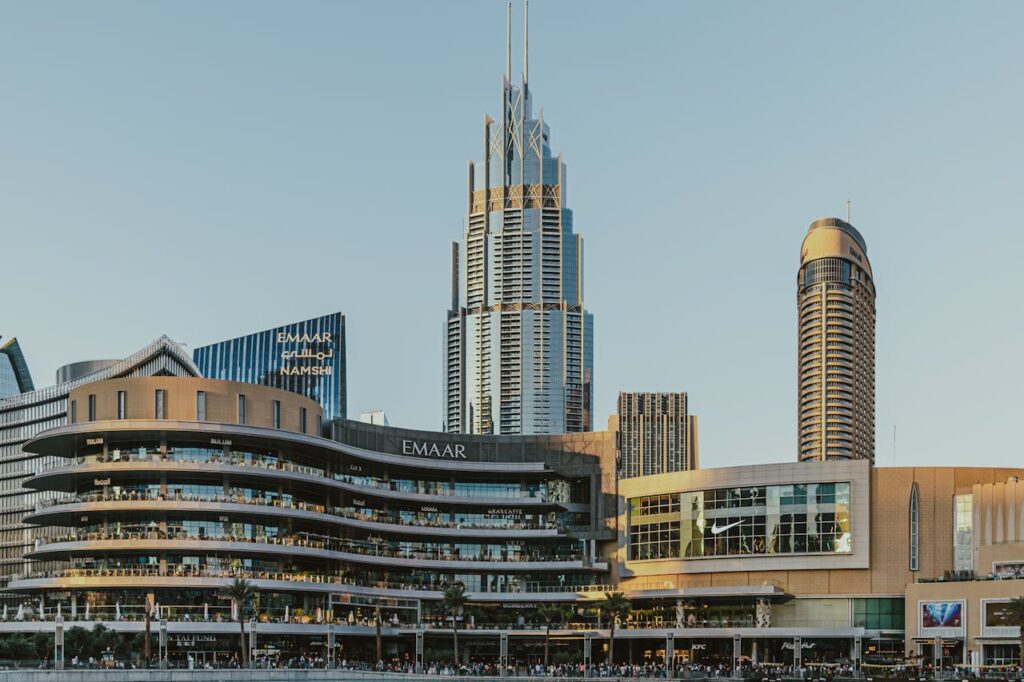
Why Visit
Calling The Dubai Mall simply a shopping center would be like calling the ocean a puddle. With over 1,200 retail outlets spanning 5.4 million square feet, this is not just one of the world’s largest shopping destinations but a complete entertainment ecosystem. You could easily spend an entire day here without stepping into a single store.
Highlights
Shopping Paradise: From high-street fashion brands to haute couture, The Dubai Mall houses every major international label. The Fashion Avenue section alone features over 150 luxury brands including Chanel, Dior, Gucci, and Louis Vuitton.
Dubai Aquarium & Underwater Zoo: One of the mall’s crown jewels, this massive aquarium holds 10 million liters of water and features:
- Over 140 species of aquatic animals
- A 48-meter walk-through tunnel offering 270-degree views
- Sand tiger sharks, rays, and countless tropical fish
- An underwater zoo on the upper level with penguins, otters, and crocodiles
Dubai Ice Rink: An Olympic-sized ice skating rink where you can glide across the ice while surrounded by luxury shopping. Skate rentals and lessons are available for all skill levels.
VR Park: Spanning 7,000 square meters, this virtual and augmented reality attraction offers immersive experiences from horror adventures to racing simulations.
KidZania: An interactive edutainment center where children aged 4-16 can role-play various professions in a kid-sized city.
Dubai Dino: Marvel at the 155-million-year-old, 24-meter-long Diplodocus skeleton displayed in the mall’s Grand Atrium. This real fossil was discovered in Wyoming and is one of the most complete dinosaur skeletons ever found.
Best Time to Visit
Weekday mornings (10:00 AM to 1:00 PM) offer the most relaxed shopping experience with minimal crowds. Weekends and evenings can get extremely busy, especially during Dubai Shopping Festival (January-February) and Dubai Summer Surprises (July-August).
Dining Options
With over 200 dining establishments ranging from quick bites to fine dining, you’ll find:
- International cuisine spanning Japanese, Italian, Indian, Chinese, and Middle Eastern
- Waterfront dining overlooking the Dubai Fountain
- Celebrity chef restaurants including Social House and Thiptara
Insider Shopping Tips
- Download The Dubai Mall app for interactive maps and exclusive offers
- Visit the Gold Souk section within the mall for traditional jewelry shopping
- Check the information desks for same-day shopping deals and promotions
- The mall offers free WiFi throughout
- Valet parking is available, but arrive early on weekends as parking fills quickly
How to Get There
Nearest Metro Station: Burj Khalifa/Dubai Mall Station (Red Line)
Direct covered walkway access from the metro station. Alternatively, taxis and ride-sharing services drop off at multiple mall entrances.
3. Palm Jumeirah
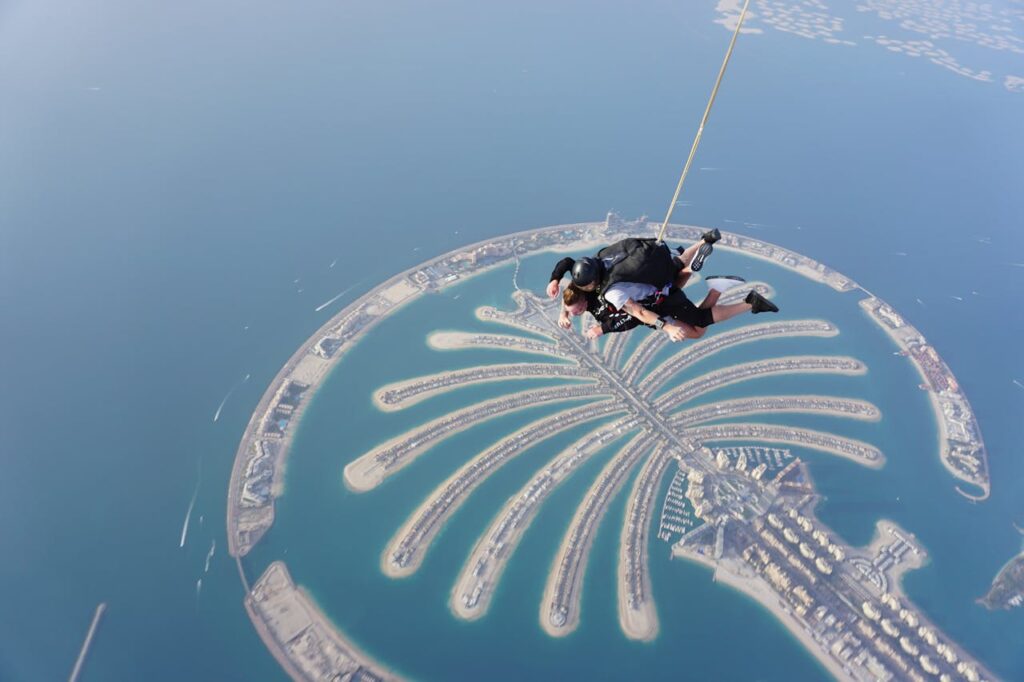
Visible from space, Palm Jumeirah represents human engineering at its most ambitious. This artificial archipelago, shaped like a stylized palm tree, stretches 5 kilometers into the Arabian Gulf and stands as one of Dubai’s most recognizable landmarks. The combination of pristine beaches, world-class resorts, and stunning architecture makes it essential viewing.
Highlights
Atlantis The Palm: This mega-resort anchors the island’s crown and offers:
- Aquaventure Waterpark: One of the largest waterparks in the Middle East with thrilling slides and a private beach
- The Lost Chambers Aquarium: Themed around the lost city of Atlantis, featuring 65,000 marine animals
- Dolphin Bay: Interactive experiences with dolphins in a stunning lagoon setting
- Multiple celebrity chef restaurants including Nobu and Gordon Ramsay’s Bread Street Kitchen
The Pointe: A waterfront dining and entertainment destination at the Palm’s apex featuring:
- Over 50 restaurants and cafés with fountain views
- The Palm Fountain: A record-breaking fountain with synchronized light and water shows
- Outdoor promenades perfect for evening strolls
- Stunning views of Atlantis and the Dubai Marina skyline
Palm West Beach: Dubai’s newest beach club destination offering:
- Crystal-clear waters and white sand beaches
- Beach clubs and water sports facilities
- Casual dining options with sunset views
- Perfect Instagram backdrops with Palm Jumeirah fronds visible
Best Time to Visit
November through April provides the most comfortable beach weather, with temperatures ranging from 24-30°C (75-86°F). Early morning and late afternoon offer the best light for photography, while evenings at The Pointe come alive with fountain shows and cooler temperatures.
Transportation
Palm Monorail: Connects the Gateway Station at the island’s base to Atlantis, offering spectacular views during the journey.
Water Taxi: Scenic boat rides connecting various points around the Palm.
Private Car/Taxi: Most convenient for exploring multiple locations on the island.
Pro Tips
- Walk the Palm Jumeirah boardwalk for the best free views
- Book restaurant reservations in advance, especially for sunset dining
- The Palm Fountain shows run every 30 minutes from 6:00 PM to midnight
- Visit the Palm Jumeirah View at The Pointe for 360-degree photo opportunities
- Consider staying overnight at one of the island’s resorts for the full experience
4. Dubai Marina
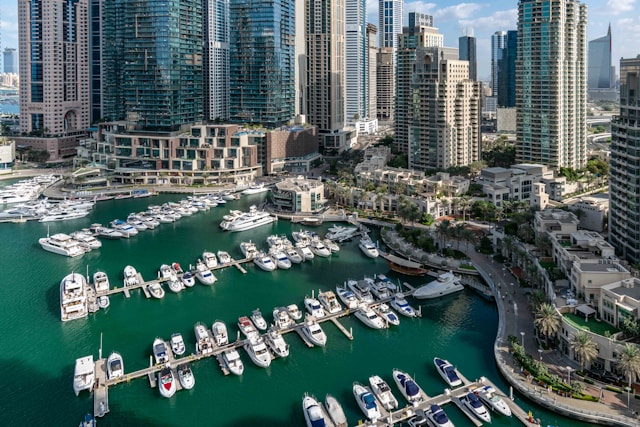
Why Visit
Dubai Marina pulses with cosmopolitan energy, showcasing Dubai’s modern face through sleek skyscrapers, luxury yachts, and a vibrant waterfront lifestyle. This man-made canal city, carved along a 3-kilometer stretch of Persian Gulf shoreline, feels more like Monte Carlo than the Middle East.
Highlights
Dubai Marina Walk: A 7-kilometer pedestrian promenade lined with:
- Over 200 cafes, restaurants, and retail outlets
- Outdoor seating areas perfect for people-watching
- Street performers and live entertainment on weekends
- Waterfront views of luxury yachts and modern architecture
Marina Cruise Experiences: Several operators offer cruises including:
- Traditional dhow dinner cruises with Arabic entertainment
- Luxury yacht charters for private celebrations
- Sunset cruises offering spectacular photography opportunities
- Speed boat tours for adrenaline seekers
Ain Dubai Views: While the world’s largest observation wheel is currently on pause, the Dubai Marina offers excellent viewing points to appreciate its massive scale and the surrounding waterfront development.
JBR Beach & The Walk: Adjacent to the Marina, Jumeirah Beach Residence features:
- 2 kilometers of pristine beach
- Water sports and beach activities
- The Walk at JBR: an outdoor shopping and dining strip
- Beach clubs and casual dining with sand between your toes
Best Time to Visit
Evening hours (after 5:00 PM) bring Dubai Marina to life. The setting sun casts golden hues across the water, the temperature becomes pleasant, and the promenade buzzes with activity. Weekends feature live music and entertainment at various venues.
For peaceful morning strolls and breakfast with a view, visit between 7:00 AM and 10:00 AM.
Nightlife & Dining
The Marina boasts some of Dubai’s hottest nightlife spots:
- Rooftop bars with skyline views
- Beach clubs transitioning from day to night parties
- International restaurants offering every cuisine imaginable
- Shisha cafes for traditional Middle Eastern relaxation
How to Get There
Dubai Tram: Connects seamlessly with the Dubai Metro Red Line at DAMAC Properties and Jumeirah Lake Towers stations. The tram stops at multiple Marina locations.
Dubai Metro: DAMAC Properties and Ibn Battuta stations (Red Line) provide access.
Water Bus: A scenic option connecting Marina Walk with various waterfront destinations.
Pro Tips
- Marina Mall offers good shopping options and direct beach access
- Evening yacht cruises book up quickly, especially on weekends
- Many restaurants offer “ladies’ nights” with special promotions
- The Dubai Tram is the most convenient way to explore the entire Marina area
- Photography is best during golden hour (an hour before sunset)
5. Al Fahidi Historical District (Al Bastakiya)
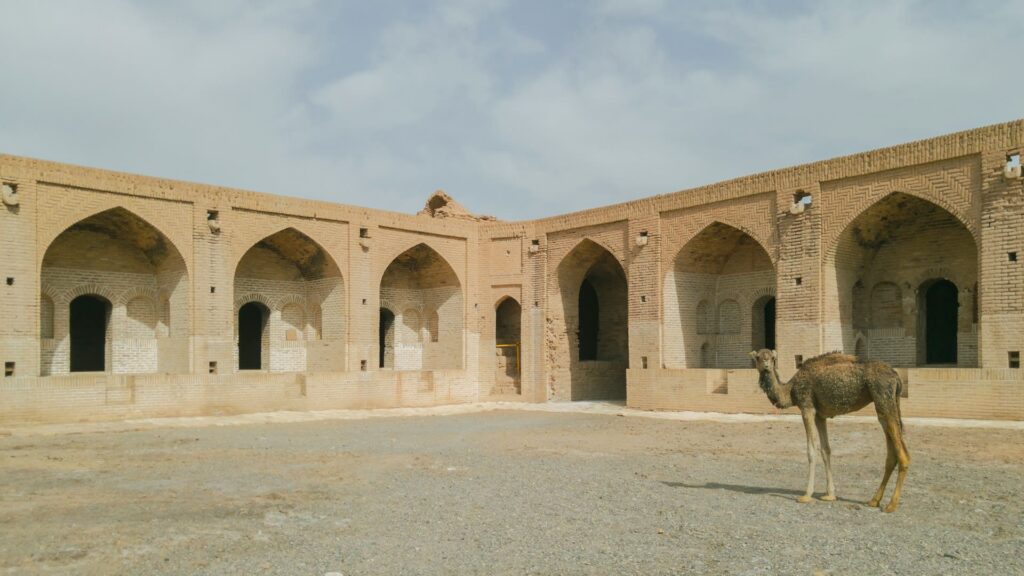
Why Visit
Step back in time to discover Dubai before skyscrapers and superlatives. Al Fahidi Historical District, also known as Al Bastakiya, offers an intimate glimpse into Emirati life from the late 19th and early 20th centuries. This heritage area stands as a powerful reminder that Dubai’s roots run deep beneath its modern surface.
Highlights
Traditional Architecture: The district’s signature wind-tower houses (barjeel) showcase ingenious pre-electricity cooling systems. These tall towers captured desert breezes and channeled them down into living spaces below, providing natural air conditioning in the scorching heat.
Dubai Museum: Located in Al Fahidi Fort (built in 1787, Dubai’s oldest existing building), this museum offers:
- Dioramas depicting traditional Emirati life
- Archaeological artifacts from 3000-year-old sites
- Recreations of souks, houses, and desert life
- Historical pearling and maritime displays
Coffee Museum: A unique attraction celebrating the history and culture of coffee in the region:
- Antique coffee-making equipment
- Cultural coffee ceremonies
- Working cafe serving traditional Arabic coffee
- Free admission
Art Galleries: The narrow lanes house numerous contemporary art galleries including:
- XVA Gallery: Showcasing Middle Eastern and international artists
- Majlis Gallery: Dubai’s oldest commercial art gallery
- The Courtyard: A cultural hub with rotating exhibitions
Sheikh Mohammed Centre for Cultural Understanding: Offers guided tours, traditional Emirati meals, and cultural programs designed to bridge cultural gaps and promote understanding.
Best Time to Visit
Early morning hours (8:00 AM to 11:00 AM) provide the most comfortable temperatures for wandering the outdoor lanes and alleys. The soft morning light also creates beautiful photography opportunities, highlighting the textures of coral stone walls and wooden doors.
Avoid midday visits from June through September, when temperatures can make outdoor exploration challenging.
Nearby Attractions
Dubai Creek: Just steps away, where you can catch traditional abra (water taxi) rides.
Textile Souk: Browse fabrics from across Asia in this covered marketplace.
Traditional Emirati Cafes: Sample local snacks like luqaimat (sweet dumplings) and karak chai (spiced tea).
How to Get There
Nearest Metro Station: Al Fahidi Station (Green Line)
Short walk through the atmospheric lanes of old Dubai. Alternatively, taxis can drop you near the main entrance on Al Fahidi Street.
Pro Tips
- Wear comfortable walking shoes for exploring the cobblestone lanes
- Many galleries and museums close on Fridays or during afternoon hours
- Respect the quiet, residential nature of the district
- The wind towers are most impressive when viewed from the narrow alleys
- Join a guided tour through the Cultural Understanding Centre for deeper insights
- Several cafes offer traditional courtyard seating perfect for escaping the heat
6. Dubai Creek
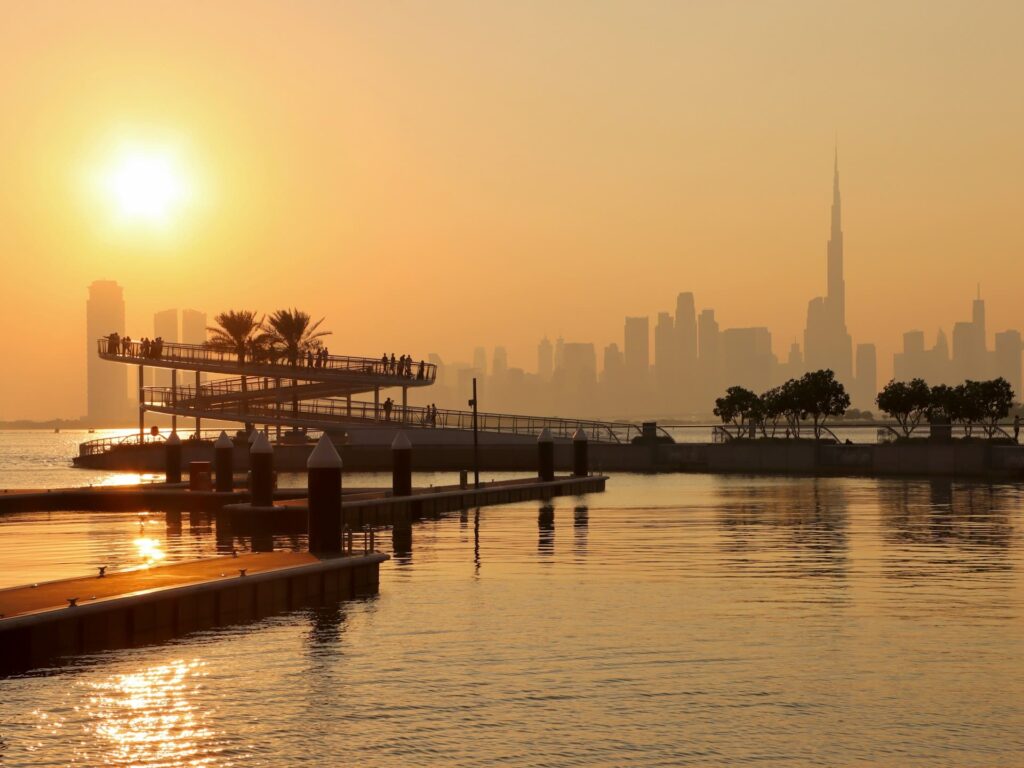
Why Visit
Dubai Creek (Khor Dubai) represents the birthplace of modern Dubai. This natural seawater inlet divided the city into two distinct sections (Deira and Bur Dubai) and served as the center of Dubai’s economy for decades. Today, the Creek beautifully balances preservation of heritage with contemporary development.
Highlights
Traditional Souks: The Creek area hosts Dubai’s most authentic marketplaces:
Gold Souk (Deira side):
- Over 300 retailers offering gold, diamonds, and precious stones
- Competitive prices due to low taxes and high competition
- Stunning window displays of elaborate jewelry
- Bargaining is expected and encouraged
Spice Souk (Deira side):
- Aromatic alleys filled with sacks of spices, herbs, and incense
- Saffron, frankincense, dried lemons, and exotic seasonings
- Traditional remedies and medicinal herbs
- Perfect for unique, portable souvenirs
Perfume Souk:
- Traditional Arabic attars (oil-based perfumes)
- Custom fragrance blending services
- Oud (agarwood) and other regional scents
Al Seef District: A beautifully developed waterfront area blending heritage and contemporary design:
- Traditional architecture housing modern cafes and restaurants
- Waterfront promenade with Creek views
- Boutique shopping featuring Emirati designers
- Regular cultural events and performances
Abra Rides: For just 1 AED, these traditional wooden water taxis ferry passengers across the Creek, offering:
- Authentic local transportation experience
- Photographic views of both traditional and modern architecture
- Quick access between Deira and Bur Dubai
- Operating from approximately 6:00 AM to midnight
Dhow Dinner Cruises: Traditional wooden boats transformed into floating restaurants:
- International buffet dinners with local specialties
- Live entertainment including traditional music and dance
- Two-hour cruises along the Creek
- Views of illuminated souks and modern buildings
Dubai Creek Harbour: The Creek’s newest development featuring:
- Dubai Creek Tower (under construction, planned to surpass Burj Khalifa)
- Ras Al Khor Wildlife Sanctuary viewpoints
- Modern residential and retail developments
- Waterfront parks and promenades
Best Time to Visit
Sunset hours create magical lighting conditions as the low sun illuminates traditional buildings with golden light. Evening visits (6:00 PM to 10:00 PM) allow you to experience the souks at their most atmospheric, with cooler temperatures making shopping more comfortable.
For photographers, early morning (6:00 AM to 8:00 AM) offers soft light and the opportunity to capture the Creek coming to life.
Cultural Experiences
The Creek area provides some of Dubai’s most authentic cultural encounters:
- Watch traditional boat builders at work in the dhow shipyards
- Sample authentic Emirati street food from local vendors
- Observe the daily rhythms of local commerce unchanged for generations
- Experience the call to prayer echoing across the water from nearby mosques
How to Get There
Nearest Metro Stations:
- Al Ras Station (Green Line) for Deira-side souks
- Al Fahidi Station (Green Line) for Bur Dubai side
Both stations are within easy walking distance of the Creek and souks.
Pro Tips
- Start your souk visit with the Spice Souk, as it’s smaller and less overwhelming
- In the Gold Souk, shops are required to display prices by weight, ensuring fair pricing
- Bargaining is expected; start at 50-60% of the asking price
- Private abra tours (50-100 AED) offer more flexible, personalized experiences
- Book dhow cruises directly with operators for better rates than hotel concierges
- Visit Ras Al Khor Wildlife Sanctuary nearby to see flamingos and other birds
- The Creek Walk connects multiple heritage and modern attractions along the waterfront
7. Jumeirah Mosque & Jumeirah Beach
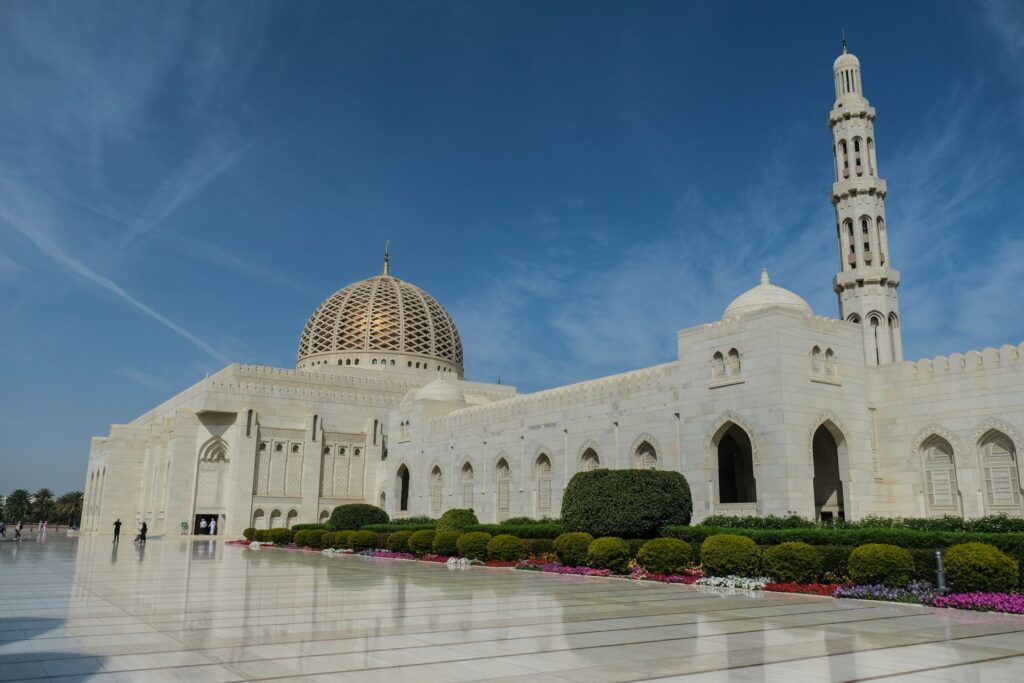
This combination offers a perfect balance of cultural enrichment and coastal relaxation. Jumeirah Mosque stands as one of Dubai’s most photographed landmarks and one of the few mosques in the UAE open to non-Muslim visitors, while Jumeirah Beach provides classic Dubai coastline experiences with views of the iconic Burj Al Arab.
Jumeirah Mosque Highlights
Jumeirah Mosque: Built in the medieval Fatimid tradition, the mosque features:
- Twin minarets reaching towards the sky
- Intricate stonework and geometric patterns
- Capacity for 1,200 worshippers
- Stunning illumination after dark making it a photographer’s dream
Learn more about visiting through the Sheikh Mohammed Centre for Cultural Understanding.
Cultural Tours: The Sheikh Mohammed Centre for Cultural Understanding conducts tours that include:
- Explanation of Islamic faith, customs, and traditions
- Architectural tour of the mosque’s features
- Q&A session where visitors can ask anything about Islam and Emirati culture
- Traditional Emirati refreshments
- Tours available Saturday through Thursday at 10:00 AM
Open Doors, Open Minds Philosophy: The mosque’s welcoming approach helps bridge cultural understanding, with knowledgeable guides answering questions about prayer practices, Islamic architecture, and daily Muslim life.
Mosque Visit Etiquette
- Dress modestly: Women should cover hair, arms, and legs; men should wear long pants and shirts with sleeves
- The mosque provides abayas and shayla for women if needed
- Remove shoes before entering
- Photography is permitted and encouraged
- Tours last approximately 75 minutes
- Advance booking recommended, especially during peak season
Jumeirah Beach Highlights
Public Beach Access: Multiple access points along the Jumeirah coastline offer:
- Pristine white sand beaches
- Clear turquoise waters ideal for swimming
- Designated areas for water sports including jet skiing, paddle boarding, and kayaking
- Picnic areas and shaded spots
- Clean facilities and lifeguard services
Burj Al Arab Views: The beach provides unobstructed views of Dubai’s most iconic hotel:
- Perfect photo opportunities, especially during sunset
- The sail-shaped structure appears to float on the water
- Various viewing angles available along the beach stretch
Kite Beach: A particularly popular section featuring:
- Active water sports scene including kitesurfing
- Beach volleyball courts
- Outdoor gym equipment
- Skate park
- Food trucks and casual dining
- Vibrant, youthful atmosphere
Sunset Beach: Adjacent to Burj Al Arab with:
- Calm waters perfect for families
- Fewer crowds than Kite Beach
- Jogging and cycling tracks
- Beachfront cafes
Best Time to Visit
Mosque: Morning tours (10:00 AM) provide comfortable temperatures and excellent natural lighting for photography. External viewing and photography are stunning after dark when the mosque is illuminated.
Beach: Visit during cooler months (November through April) for the most comfortable beach experience. Early morning (7:00 AM to 10:00 AM) and late afternoon (4:00 PM onwards) offer pleasant temperatures even during summer months. Sunset viewing (around 6:00 PM to 7:00 PM) provides spectacular light for photographing Burj Al Arab.
How to Get There
Mosque: Limited public transport access; taxis or ride-sharing services are most convenient. Located on Jumeirah Beach Road (also known as Beach Road).
Beach: Multiple bus routes serve Jumeirah Beach Road, or use taxis/ride-sharing services to reach specific beach access points.
Pro Tips
- Combine mosque tour and beach visit in one morning
- Bring swimwear, sunscreen, and water for beach visits
- Several beach-adjacent hotels offer day passes including beach and pool access
- Street parking along Beach Road is available but can be challenging on weekends
- Modest dress is appropriate when moving between beach and surrounding areas
- Kite Beach has the best facilities and food options
- Photography of the mosque exterior is free and unrestricted at any time
8. Desert Safari
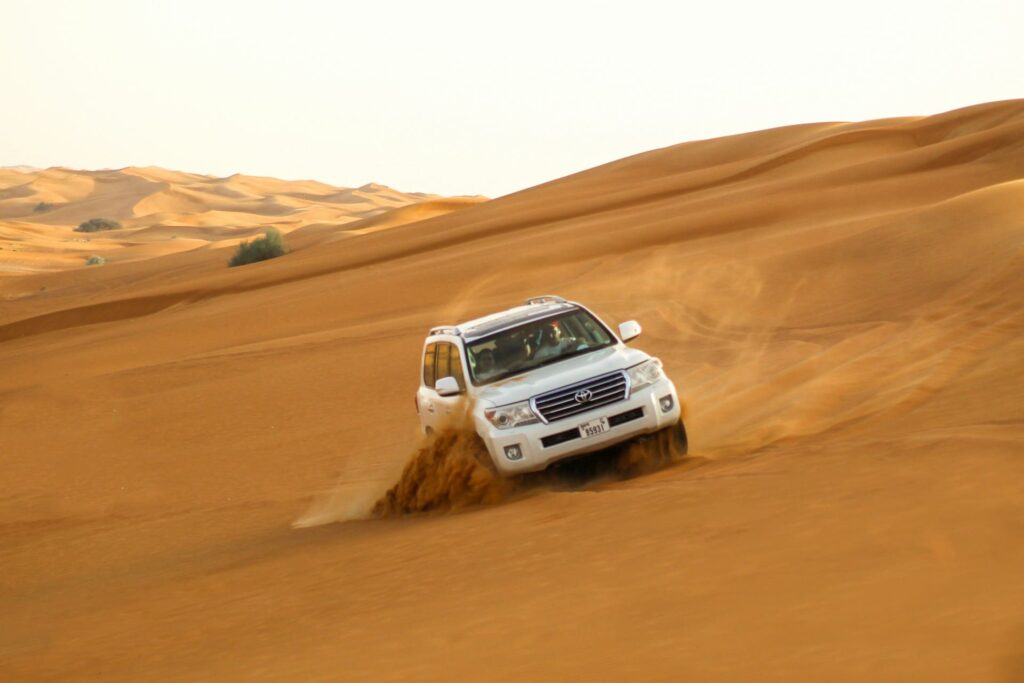
Why Visit
No visit to Dubai is complete without experiencing the Arabian Desert. A desert safari provides adventure, cultural immersion, and natural beauty all in one unforgettable experience. The vast, golden dunes stretching to the horizon remind visitors that Dubai’s heart beats with ancient desert rhythms beneath its modern exterior.
Highlights
Dune Bashing: The adrenaline-pumping highlight for thrill-seekers:
- Expert drivers navigate 4×4 vehicles over massive sand dunes
- Roller-coaster-like experience of climbing and descending steep dunes
- Typically 30-45 minutes of heart-racing action
- Photographers can capture stunning desert landscapes during brief stops
Camel Riding: Experience traditional desert transportation:
- Gentle rides through the dunes
- Photo opportunities in traditional Bedouin dress
- Learn about camels’ importance in Emirati culture
- Short rides included with most packages; longer treks available
Sandboarding: Desert surfing down steep dunes:
- Equipment provided by tour operators
- Similar technique to snowboarding
- Suitable for all ages and skill levels
- Exhilarating way to engage with the landscape
Bedouin-Style Camp Experience: Most safaris conclude at a traditional desert camp offering:
- Arabian hospitality: Welcome dates and Arabic coffee
- Henna painting: Traditional temporary body art
- Shisha smoking: Water pipes with flavored tobacco
- Traditional dress: Try on kandura (men) or abaya (women) for photos
- Falcon displays: Watch these majestic birds and learn about falconry’s cultural significance
Evening Entertainment: As night falls, enjoy:
- Belly dancing performances
- Tanoura dance shows (spinning Sufi dance)
- Fire shows and acrobatics
- Traditional music and drumming
- Stargazing in the clear desert sky
BBQ Dinner: Feast on international and Arabic buffets including:
- Grilled meats and shawarma
- Traditional mezze and salads
- Local desserts like luqaimat and umm ali
- Vegetarian and dietary options available
Dubai Desert Conservation Reserve
For eco-conscious travelers, tours within the Dubai Desert Conservation Reserve offer:
- Protected habitat for native wildlife including Arabian oryx, gazelles, and desert foxes
- Sustainable tourism practices
- Educational components about desert ecology
- More pristine, less crowded desert landscape
- Support for conservation efforts
- Premium experience focused on nature and wildlife rather than entertainment
Safari Options
Morning Safari (6:00 AM to 11:00 AM):
- Cooler temperatures ideal for sensitive travelers
- Better wildlife spotting opportunities
- Includes dune bashing and breakfast
- Less crowded desert landscape
- Perfect for photographers seeking dramatic morning light
Evening Safari (3:00 PM to 9:00 PM):
- Most popular option with full entertainment package
- Sunset in the desert
- Traditional dinner and shows
- Cooler temperatures than midday
- Romantic atmosphere under the stars
Overnight Safari:
- Complete desert immersion
- Sleeping under the stars in Bedouin-style tents
- Sunrise viewing
- Quiet evening desert experience after day-trippers leave
- Premium pricing but unforgettable memories
Premium/Luxury Safaris:
- Smaller group sizes or private tours
- Higher-quality vehicles and services
- Gourmet dining options
- Additional activities like hot air ballooning or falconry experiences
- More time at each activity
Best Time to Visit
Cooler months (October through April) provide the most comfortable desert experience. Summer safaris (May through September) operate primarily during early morning or late evening hours to avoid extreme heat.
What to Bring
- Sunglasses and sunscreen (essential year-round)
- Light, loose-fitting clothing
- Closed-toe shoes for activities
- Camera with extra batteries
- Light jacket for evening (desert temperatures drop significantly)
- Hat or scarf for sun protection
- Any necessary medications (especially motion sickness remedies for dune bashing)
Booking Tips
- Book through reputable tour operators with good safety records
- Read reviews carefully, especially regarding dune bashing intensity
- Inform operators of any medical conditions (pregnant women and those with back problems should avoid dune bashing)
- Most hotels can arrange safari bookings, but direct booking often offers better rates
- Pick-up and drop-off at your hotel is typically included
- Small group or private tours offer more personalized experiences
Pro Tips
- Sit in the front seat during dune bashing for the most thrilling experience
- Arrive early to camp to secure good seating for evening shows
- The “golden hour” before sunset provides stunning photography opportunities
- Vegetarian meal options are available with advance notice
- Avoid heavy meals before dune bashing
- Conservation Reserve tours must be booked with authorized operators
- Many operators offer photography packages for capturing your desert adventure
9. Dubai Miracle Garden
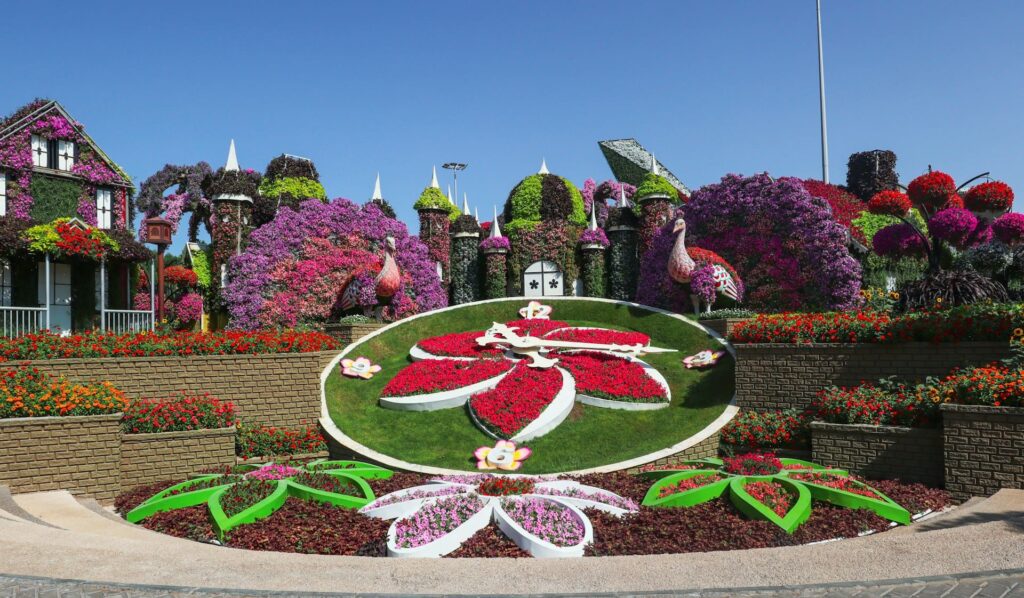
Dubai Miracle Garden defies desert logic by blooming with over 150 million flowers across 72,000 square meters, making it the world’s largest natural flower garden. This horticultural marvel showcases Dubai’s ability to create the extraordinary through innovation, determination, and creative vision.
Highlights
Floral Structures: The garden features elaborate displays including:
- Full-sized airplane (Emirates A380) covered in flowers: Certified by Guinness World Records as the largest floral structure
- Mickey Mouse and Disney characters in blooms
- Heart-shaped pathways and archways
- Flower-covered houses, cars, and castles
- Pyramids and elaborate geometric designs
- Themed gardens including butterfly, aromatic, and succulent gardens
Butterfly Garden: Adjacent to Miracle Garden, featuring:
- Over 15,000 butterflies from 50 species
- Climate-controlled domes replicating butterflies’ natural habitats
- Educational displays about butterfly lifecycles
- Photo opportunities with butterflies landing on visitors
- Separate admission ticket required
Seasonal Displays: Designs change annually, ensuring repeat visitors always experience something new. Recent seasons have featured:
- Smurfs village
- Floating lady installation
- Emirates A380 replica (permanent feature)
- Floral clock and sundials
- International monuments recreated in flowers
Aromatic Garden: Features fragrant flowers and herbs:
- Lavender fields creating purple pathways
- Rose gardens in countless varieties
- Herb gardens with culinary and medicinal plants
- Sensory experience engaging sight and smell
Best Time to Visit
Seasonal Operation: The garden operates only during November through April/May, closing during the hot summer months when maintaining the flowers becomes impractical.
Best visiting times during the season:
- Weekday mornings (9:00 AM to 12:00 PM): Fewer crowds, fresh flowers, pleasant temperatures
- Late afternoon (4:00 PM to 7:00 PM): Cooler temperatures, beautiful lighting for photography
- Avoid Friday afternoons and weekends when crowds peak
Perfect For
Families: Children love the Disney characters and colorful displays. Wide pathways accommodate strollers, and numerous photo opportunities keep kids engaged.
Couples: Romantic setting perfect for dates and proposals. Several wedding and event spaces available for private functions.
Photography Enthusiasts: Instagram-worthy scenes at every turn. Professional photography is permitted for personal use.
Nature Lovers: Despite the artificial setting, the sheer volume and variety of blooms creates a sensory feast.
Practical Information
Duration: Plan for 2-3 hours to explore the entire garden leisurely. Quick visits can be completed in 90 minutes.
Facilities:
- Multiple entry points
- Prayer rooms
- Baby changing facilities
- Wheelchair accessible
- Small electric carts available for elderly or disabled visitors
- Food kiosks and cafes scattered throughout
- Gift shop selling seeds, plants, and souvenirs
Photography: Unlimited personal photography allowed. Professional equipment permitted. Several professional photography services offer packages within the garden.
How to Get There
Location: Al Barsha South, near Motor City
By Car: Ample paid parking available (free parking with admission ticket for first 4 hours)
By Metro/Bus: Limited direct public transport; most convenient to take metro to nearest station then taxi/ride-share for final leg
By Tour: Many Dubai city tours include Miracle Garden, and dedicated tour packages are available
Pro Tips
- Purchase tickets online in advance for slight discounts and to skip ticket counter lines
- Visit early in the season (November) when flowers are freshest
- Wear comfortable walking shoes as the garden covers extensive ground
- Bring water, though refreshments are available throughout
- The Emirates A380 display is the most popular photo spot, so arrive early to avoid queues
- Combination tickets with Butterfly Garden offer better value
- Garden is mostly outdoors; wear sun protection
- Peak bloom occurs mid-season (December-January)
- Some structures may be under renovation for seasonal design changes
- Free WiFi available throughout the garden
10. Global Village
Why Visit
Global Village represents cultural diversity in its most celebratory form. This seasonal open-air theme park brings together pavilions from over 75 countries, creating a miniature world tour where you can shop Egyptian textiles, taste Turkish delight, watch Indian dance performances, and ride thrilling attractions, all in a single evening.
Highlights
Country Pavilions: Each pavilion represents a nation or region with:
- Traditional architecture reflecting cultural heritage
- Authentic merchandise from handcrafts to fashion
- Cultural performances and demonstrations
- Food stalls serving national specialities
- Friendly vendors eager to share their culture
Popular pavilions include:
- India: Textiles, spices, jewelry, and traditional clothing
- Egypt: Papyrus art, perfumes, and authentic Egyptian cuisine
- Turkey: Carpets, ceramics, sweets, and traditional lamps
- China: Electronics, silk products, tea sets, and Chinese medicine
- Morocco: Leather goods, argan oil, lanterns, and traditional crafts
- Afghanistan: Carpets, nuts, and dried fruits
- Thailand: Silk products, handicrafts, and Thai street food
Fantasy Island: A complete amusement park section featuring:
- Over 40 thrilling rides including roller coasters
- Family-friendly attractions for all ages
- Ferris wheel offering views of the entire village
- Games and carnival attractions
- Separate ride tickets or unlimited ride bands available
Street Performances: Daily entertainment throughout the village:
- Acrobatic shows and circus acts
- Cultural dance performances
- Street magicians and entertainers
- Parades featuring international themes
- Live music from various cultures
- Special weekend performances with international artists
Food Paradise: A true global culinary journey:
- Street food from every continent
- Traditional dishes prepared by native chefs
- Desserts from baklava to Belgian waffles
- Fresh juices and traditional beverages
- International restaurant section with sit-down dining
- Food courts offering variety for families
Shopping Experience: Unique marketplace atmosphere:
- Bargaining is expected and part of the fun
- Competitive pricing between similar vendors
- Unique items not found in regular Dubai malls
- Tax-free shopping environment
- Opportunity to support small artisans and businesses
Seasonal Operation
Open: Late October through mid-April (exact dates vary by year)
Hours: Typically 4:00 PM to midnight on weekdays; 4:00 PM to 1:00 AM on weekends and holidays
Special Events: Extended hours during UAE National Day (December 2), New Year’s Eve, and holidays
Best Time to Visit
Weekday evenings (Monday through Thursday) offer the most comfortable visiting experience with manageable crowds. Arrive around 5:00 PM to explore pavilions before they get busy, enjoy early dinner, and watch performances as evening progresses.
Avoid Friday and Saturday evenings when the village reaches capacity and parking becomes challenging. If visiting on weekends, arrive right at opening time (4:00 PM) or wait until after 9:00 PM when some crowds disperse.
Best months: November and December offer pleasant weather and full festive atmosphere without the peak season pricing of January and February.
Practical Information
Entry Fee: Approximately 25 AED (subject to change)
Duration: Plan for 3-4 hours minimum; full experience can take an entire evening
Facilities:
- Prayer rooms and family facilities
- First aid centers
- ATMs throughout the village
- Lost and found services
- Free WiFi in designated areas
- Wheelchair and stroller rental
Payment: Most pavilions accept cash and cards; some smaller vendors prefer cash
How to Get There
Location: Exit 37 off Sheikh Mohammed Bin Zayed Road (E311), near Arabian Ranches
By Car: Massive parking lots available (parking fees apply)
By Public Transport:
- Dubai Bus: Multiple routes serve Global Village including 103, 104, 105, 106, and 107
- RTA Special Bus Service: Direct buses from multiple locations during operating season
- Metro: Nearest station is Jebel Ali (Red Line), then bus or taxi
By Tour: Many operators offer packages including transportation and entry
Pro Tips
- Download the Global Village app for interactive maps and show schedules
- Start at less popular pavilions (African, European) which are less crowded early evening
- Save popular Asian pavilions (India, China, Pakistan) for later when crowds thin
- Bargain assertively; initial prices are typically 50-100% higher than final selling price
- Compare prices between similar vendors before committing
- Bring a bag for shopping; plastic bags cost extra at many pavilions
- Try foods from countries you haven’t experienced before
- Show schedules are posted at entrances and in the app
- VIP lounges offer exclusive shopping and comfortable seating for a premium
- Special packages available for families and groups
- Visit during cultural celebration weeks for enhanced programming
- The Carnaval section features weekend-only entertainment and international acts
Data Table: Attraction Overview
| Attraction | Type | Best Time to Visit | Entry Fee (AED) | Nearest Metro/Area |
|---|---|---|---|---|
| Burj Khalifa | Landmark | Sunset | 169+ | Burj Khalifa/Dubai Mall |
| Dubai Mall | Shopping/Entertainment | Year-round | Free | Burj Khalifa/Dubai Mall |
| Palm Jumeirah | Island/Beach | Nov-Apr | Free | Monorail Access |
| Dubai Marina | Neighbourhood | Evening | Free | DAMAC Properties |
| Al Fahidi District | Heritage | Morning | Free | Al Fahidi |
| Dubai Creek | Waterfront | Sunset | Free-Varies | Al Ras |
| Jumeirah Mosque | Religious/Cultural | Morning | 35 | Jumeirah |
| Desert Safari | Adventure | Afternoon | 250+ | Tour Pickup |
| Miracle Garden | Garden | Nov-Apr | 95 | Motor City |
| Global Village | Cultural Festival | Oct-Apr | 25 | Global Village Stop |
Cultural Context: Understanding Dubai Beyond the Attractions
Dubai’s magic lies not just in its architectural achievements but in its unique cultural identity. Understanding this context enriches every experience in the city.
Emirati Heritage Meets Global Influence
Dubai successfully balances traditional Emirati values with cosmopolitan dynamism. Over 85% of Dubai’s population consists of expatriates from over 200 nationalities, creating one of the world’s most diverse cities. Yet Emirati culture remains the foundation, visible in:
- The call to prayer echoing five times daily from mosques
- Traditional dress worn proudly by local men (kandura) and women (abaya)
- Majlis (gathering spaces) culture emphasizing hospitality
- Arabic language alongside English in signage and communication
- Islamic principles guiding law and social norms
Local Etiquette
Respecting local customs ensures positive interactions:
Dress Modestly: In public spaces, cover shoulders and knees. Beaches and pools allow swimwear; malls and restaurants require modest coverage.
Public Behavior: Public displays of affection beyond hand-holding are discouraged. Respect prayer times when businesses may briefly close.
Photography: Always ask permission before photographing people, especially women. Avoid photographing government buildings and military installations.
Ramadan Respect: During the holy month, eating, drinking, and smoking in public during daylight hours is prohibited and punishable. Many restaurants close or offer screened dining areas.
Right Hand Rule: Use your right hand for eating, greeting, and exchanges as the left is considered unclean in Islamic culture.
Authentic Emirati Cuisine
While Dubai offers every international cuisine imaginable, seeking authentic Emirati food provides cultural insight:
Must-Try Dishes:
- Al Harees: Slow-cooked wheat and meat dish
- Machboos: Spiced rice with meat or fish (UAE’s national dish)
- Luqaimat: Sweet dumplings with date syrup
- Karak Chai: Spiced tea with condensed milk
- Shawarma: While Middle Eastern, it’s ubiquitous and delicious
- Umm Ali: Bread pudding dessert with nuts and raisins
- Camel meat: Traditional protein served in various preparations
Where to Experience Authentic Emirati Food:
- Al Fanar Restaurant & Cafe: Multiple locations serving traditional Emirati meals
- Arabian Tea House: In Al Fahidi district, offering traditional courtyard dining
- Seven Sands: Modern Emirati cuisine in Jumeirah
- Local cafeterias in Deira: Unpretentious, authentic, and affordable
- Aseelah Restaurant: At Radisson Blu, specializing in Khaleeji cuisine
Emirati Hospitality
Hospitality (karam in Arabic) forms the cornerstone of Emirati culture. If invited to an Emirati home or majlis:
- Remove shoes before entering
- Greet the eldest person first
- Accept offered Arabic coffee (ghawa) and dates
- Take at least three cups of coffee; shake the cup gently when finished
- Conversation often includes inquiries about family and health
- Gift-giving is appreciated but not expected
Understanding Dubai’s Evolution
Dubai’s transformation occurred in decades, not centuries:
1960s: Small fishing and pearl-diving village with population under 20,000 1971: UAE formation; Dubai becomes part of the new nation 1979: Jebel Ali Port opens, beginning Dubai’s logistics hub transformation 1985: Emirates Airline founded, connecting Dubai globally 1999: Burj Al Arab opens, establishing Dubai’s luxury reputation 2004: Palm Jumeirah development begins 2010: Burj Khalifa opens as world’s tallest building 2020: Dubai Expo showcases the city to the world Present: Continued innovation with sustainable city developments and future-focused projects
This rapid development explains Dubai’s unique character: a city simultaneously ancient and futuristic, traditional and experimental, local and global.
Conclusion: Why Dubai Deserves Your Journey
Dubai transcends typical tourist destinations. It’s a living laboratory where ambition meets achievement, where desert sands meet cutting-edge architecture, and where over 200 nationalities create a unique cultural mosaic. The top 10 places to visit in Dubai outlined in this guide represent just the beginning of what this extraordinary city offers.
From touching the sky at Burj Khalifa to exploring the historic alleys of Al Fahidi, from the engineered marvel of Palm Jumeirah to the authentic chaos of Dubai Creek’s souks, each destination reveals a different facet of Dubai’s multidimensional identity. The top 10 best places to visit in Dubai showcase how this city honors its heritage while fearlessly embracing the future.
But Dubai’s true magic lies beyond the famous landmarks. It’s in the genuine hospitality of people from every corner of the world calling this city home. It’s in the contrast of hearing the call to prayer while standing beneath the world’s tallest building. It’s in savoring traditional luqaimat at a heritage cafe, then hours later, dining at a Michelin-starred restaurant suspended in the clouds.
The top 10 fun places to visit in Dubai provide structure for your journey, but leave room for spontaneous discoveries: stumbling upon a hidden art gallery in Al Quoz, finding the perfect viewpoint for sunset at Dubai Marina, or striking up conversations with vendors at the Gold Souk who share stories of their homelands.
Whether you’re seeking luxury, adventure, culture, family fun, or simply experiences that exist nowhere else on Earth, Dubai delivers. The city’s relentless pursuit of “biggest,” “tallest,” and “most spectacular” isn’t mere showmanship but reflects a deeper cultural value: that human imagination and determination have no limits.
So plan your itinerary around the top 10 places to see in Dubai, but remain open to the unexpected moments that transform a good vacation into an unforgettable journey. Dubai isn’t just a destination; it’s a reminder that the future is being built today, one ambitious project at a time, in a desert that bloomed into the world’s most dynamic city.
FAQ Top 10 Places to viti in Dubai
Q1: What is the best time to visit Dubai?
A: November through March offers the most pleasant weather for the top 10 places to visit in Dubai, with temperatures ranging from 20-30°C (68-86°F). This peak season provides comfortable conditions for outdoor attractions like desert safaris, beach activities, and exploring heritage districts.
December through February is particularly popular for European visitors escaping winter. However, this peak season means higher hotel prices and more crowded attractions.
April, May, October offer shoulder season advantages: lower prices, fewer crowds, and still-manageable temperatures. June through September sees extreme heat (40-45°C/104-113°F), but indoor attractions remain comfortable, hotel rates drop significantly, and Dubai Summer Surprises offers shopping promotions.
Q2: Is Dubai expensive for tourists?
A: Dubai can accommodate both luxury and budget travelers. While known for extravagance, affordable options exist across accommodation, dining, and activities.
Budget options:
- Hotels: Budget chains and hostels from $30-60/night
- Food: Local cafeterias and shawarma stands offer meals from $3-8
- Transport: Metro and buses are efficient and inexpensive ($1-2 per journey)
- Activities: Many attractions are free (beaches, Dubai Fountain, Creek walks, heritage districts)
Mid-range experiences:
- Hotels: $80-150/night for quality properties
- Dining: Mix of local restaurants ($10-20) and casual chains
- Activities: Major attractions range from $15-50 per person
Luxury spending:
- Five-star hotels can exceed $300-1,000+ per night
- Fine dining at celebrity chef restaurants runs $100-300+ per person
- Premium experiences (private yacht charters, helicopter tours) start at $200+
Smart strategies include booking accommodations early, eating at local restaurants, using public transport, and visiting free attractions. Dubai Shopping Festival (January-February) and Summer Surprises (July-August) offer significant discounts.
Q3: Can you drink alcohol in Dubai?
A: Yes, but with specific restrictions. Alcohol consumption is legal in licensed venues including:
- Hotels (restaurants, bars, pools)
- Standalone licensed restaurants and bars
- Private clubs
- Some beach clubs
Alcohol is not available in:
- Most independent restaurants
- Malls
- Public spaces
- Traditional souks and heritage areas
Important rules:
- Drinking in public spaces or streets is illegal
- Drinking and driving has zero tolerance policies
- You must be 21+ to consume alcohol
- Public intoxication can result in arrest
- Ramadan may see restricted alcohol service even in licensed venues
Tourists can purchase alcohol from specialized stores (like African + Eastern or Maritime Mercantile International) with a valid passport, though this is primarily for residents. Most visitors simply enjoy drinks at their hotel or licensed restaurants without issues.
Q4: How many days do you need to explore Dubai?
A: 4-5 days covers the top 10 places to visit in Dubai comfortably without feeling rushed. Here’s how to allocate time:
3-day minimum itinerary:
- Day 1: Burj Khalifa, Dubai Mall, Dubai Fountain
- Day 2: Desert safari (afternoon/evening)
- Day 3: Palm Jumeirah, Dubai Marina, beach time
Ideal 5-day itinerary:
- Day 1: Burj Khalifa, Dubai Mall, fountain shows
- Day 2: Old Dubai (Al Fahidi, Dubai Creek, souks, abra rides)
- Day 3: Beach day (Jumeirah Beach, Jumeirah Mosque) + Dubai Marina evening
- Day 4: Desert safari experience
- Day 5: Palm Jumeirah exploration + seasonal attraction (Miracle Garden or Global Village)
7-day comprehensive experience: Allows for day trips (Abu Dhabi, Ras Al Khaimah), relaxation days, shopping time, and exploring neighborhoods like Al Quoz arts district and Alserkal Avenue.
Weekend trips (2-3 days) can hit major highlights but will feel rushed. Longer stays (10+ days) allow deeper cultural immersion, culinary exploration, and day trips to other Emirates.
Q5: Is public transport good in Dubai?
A: Yes, Dubai has excellent public transportation by regional standards, though it doesn’t reach everywhere.
Dubai Metro:
- Modern, fully automated, air-conditioned system
- Two lines: Red (major attractions) and Green (old Dubai)
- Clean, efficient, punctual
- Runs 5:00 AM to midnight (weekdays), extended hours weekends
- Affordable (2-8 AED depending on distance)
- Women and children-only Gold Class cabins available
- Connects: Airport, Burj Khalifa/Dubai Mall, Dubai Marina, major hotels
Dubai Tram:
- Connects Dubai Marina, JBR, and surrounding areas
- Integrates seamlessly with metro at two stations
- Air-conditioned and modern
Buses:
- Extensive network covering areas metro doesn’t reach
- Air-conditioned, clean, inexpensive
- Routes to Global Village, Miracle Garden, and other attractions
- Journey planner available via RTA website and apps
Water Transport:
- Traditional abras across Dubai Creek (1 AED)
- Modern water buses and water taxis
- Scenic but limited routes
Taxis & Ride-Sharing:
- Abundant, metered taxis (cream-colored RTA taxis or private company colors)
- Uber and Careem (regional app) widely available
- Affordable compared to Western cities
- Many drivers speak limited English; having addresses written in Arabic helps
Limitations:
- Metro doesn’t serve Palm Jumeirah (monorail connection exists)
- Some attractions require taxis (Miracle Garden, some beaches)
- Public transport less convenient for families with small children
- Weekend and evening frequency may be reduced on some bus routes
Best approach: Use metro for major attractions along its routes, taxis/ride-sharing for destinations without convenient public transport access.
Q6: Do I need a visa to visit Dubai?
A: Visa requirements depend on nationality. Check the UAE Government’s official visa information portal for the most current requirements.
Visa-free entry (for tourism, varying durations):
- Citizens of GCC countries (unlimited)
- Many Western nations including USA, UK, EU countries, Canada, Australia (typically 30-90 days)
- Many Asian countries including Japan, Singapore, South Korea
Visa on arrival (30 days, free or for a fee):
- Select nationalities can obtain tourist visas upon arrival at Dubai airports
Pre-arranged visa required:
- Citizens of many countries must obtain tourist visas before travel
- Can be arranged through airlines, hotels, or tour operators
- Multiple entry and long-term tourist visas available
Check current requirements on the UAE government’s official portal or with your airline before booking, as policies occasionally change. Most Western tourists face a simple, straightforward entry process requiring only a valid passport (minimum 6 months validity).
Q7: Is Dubai safe for tourists?
A: Dubai ranks as one of the world’s safest cities for tourists, with extremely low crime rates.
Safety highlights:
- Very low violent crime rate
- Strict law enforcement
- Well-lit, clean public spaces
- Safe to walk alone day or night in most areas
- Reliable taxi services
- Tourist police available at major attractions
- Strong surveillance and security presence
Considerations:
- Traffic can be aggressive; use pedestrian crossings and bridges
- Summer heat poses health risks; stay hydrated
- Strict laws regarding drugs (zero tolerance), public behavior, and alcohol
- Modest dress helps avoid unwanted attention
- Keep valuables secure in crowded areas like souks
- Women generally feel safe traveling solo, though modest dress is advisable
Emergency numbers:
- Police: 999
- Ambulance: 998
- Fire: 997
- Tourist police: +971 4 609 3111
Dubai’s strict laws, while sometimes seeming severe to Western visitors, contribute significantly to its safety record.
Q8: What should I wear in Dubai?
A: Dubai balances modernity with traditional Islamic values, requiring some consideration:
General guidelines:
- Cover shoulders and knees in public spaces (malls, markets, restaurants)
- Beachwear appropriate only at beaches, pools, and water parks
- Lightweight, breathable fabrics essential for heat
- Avoid see-through or very tight clothing
- Both men and women should dress modestly outside resort areas
Specific contexts:
Beaches and pools: Swimwear acceptable; avoid topless sunbathing
Malls and restaurants: Smart casual; cover shoulders and knees
Mosques: Conservative dress required; long pants/skirts, covered arms, women must cover hair (scarves often provided)
Desert safaris: Light, loose clothing; closed-toe shoes; layers for evening cooling
Fine dining: Smart dress; some venues require jackets for men
Clubs and bars: Dress codes vary; generally smart/trendy attire
Seasonal considerations:
- Summer (May-Sept): Very light, breathable fabrics; sun protection
- Winter (Nov-Mar): Light layers; evenings can be cool (15-20°C/59-68°F)
What to avoid:
- Offensive slogans or images on clothing
- Extremely short shorts or skirts
- Very revealing tops or dresses
- Beach attire away from beach areas
Emiratis typically dress traditionally (kandura for men, abaya for women), but expatriates and tourists follow the modest guidelines above. Dubai is more relaxed than some neighboring regions, but respect for local customs is appreciated.
Q9: Can I use my credit card in Dubai?
A: Yes, credit cards are widely accepted throughout Dubai, making cashless transactions convenient.
Where cards work:
- Hotels and resorts
- Shopping malls and major retailers
- Restaurants (especially in malls and tourist areas)
- Attractions and theme parks
- Taxis (most accept card payments)
- Metro ticket machines
Where cash is preferred:
- Traditional souks (Gold Souk, Spice Souk)
- Small independent restaurants
- Street vendors and food trucks
- Abra boats (1 AED rides)
- Tips for hotel staff and tour guides
- Some smaller shops in older districts
Currency notes:
- Local currency is UAE Dirham (AED)
- Exchange rate typically around 3.67 AED = 1 USD (pegged currency)
- Major credit cards (Visa, Mastercard, Amex) widely accepted
- Contactless payment available in many locations
- ATMs plentiful throughout the city
Money tips:
- Notify your bank of travel plans to avoid card blocks
- Carry some cash for souks, small vendors, and tips
- Exchange rates at airports are less favorable than exchange houses in the city
- Hotels often offer exchange services but may charge higher rates
- ATM withdrawals typically offer fair exchange rates
- Tipping isn’t obligatory but appreciated (10-15% in restaurants if not included)
Q10: Is Dubai family-friendly?
A: Absolutely. Dubai is exceptionally family-friendly with numerous attractions catering specifically to children and families.
Family attractions:
- Dubai Mall: KidZania, Dubai Aquarium, ice rink, VR Park
- Atlantis Aquaventure: Waterpark with slides for all ages
- IMG Worlds of Adventure: Indoor theme park with Marvel and Cartoon Network zones
- Dubai Parks and Resorts: Multiple theme parks including Motiongate and Legoland
- Beach access: Many public beaches with calm waters and facilities
- Dubai Miracle Garden: Colorful, engaging for children
- Global Village: Cultural experience with rides and entertainment
- Desert safaris: Family-friendly tours with gentler activities available
- Dubai Garden Glow: Illuminated displays and dinosaur park
Family-friendly infrastructure:
- Excellent stroller accessibility in malls and attractions
- Clean, well-maintained public restrooms with changing facilities
- Family sections in restaurants
- Kids’ menus widely available
- Many hotels offer kids’ clubs and family-oriented activities
- Water parks and swimming pools with children’s areas
- Safe environment with low crime rates
Practical considerations:
- Summer heat limits outdoor activities; plan indoor attractions during peak heat
- Public transport accommodates families but can be crowded
- Many hotels offer family rooms or connecting rooms
- Restaurants welcome children (some may have separate family sections)
- Shopping malls often have dedicated play areas
Dubai’s emphasis on luxury and entertainment extends to family facilities, making it an excellent destination for multi-generational trips. The top 10 fun places to visit in Dubai include multiple options suitable for families with children of all ages.
Q11: What language is spoken in Dubai?
A: Arabic is the official language, but English is extremely widely spoken and understood throughout Dubai.
Practical language situation:
- Most signage is bilingual (Arabic and English)
- Service industry workers typically speak functional English
- Hotel staff, tour operators, and attraction employees speak fluent English
- Restaurant menus often available in English
- Metro and public transport announcements in Arabic and English
Other languages: Due to Dubai’s international population, you’ll hear:
- Hindi and Urdu (large South Asian population)
- Filipino/Tagalog
- Persian/Farsi
- Various European languages
- Chinese (increasingly common in tourist areas)
Useful Arabic phrases (appreciated but not necessary):
- As-salamu alaykum (Peace be upon you) – greeting
- Shukran (Thank you)
- Afwan (You’re welcome)
- Ma’a salama (Goodbye)
- Kam (How much?)
- Min fadlak/fadlik (Please – to men/women)
English-speaking tourists navigate Dubai easily without Arabic knowledge. The multicultural environment means communication is generally straightforward.
Q12: Can I take photos everywhere in Dubai?
A: Generally yes, but with important restrictions and courtesies:
Photography encouraged:
- Tourist attractions and landmarks
- Beaches and public parks
- Your food and meals
- Dubai skyline and architecture
- Souks and marketplaces (though ask vendors first)
- Desert landscapes
- Dubai Fountain shows
- Inside malls (usually permitted)
Photography restricted or prohibited:
- Government buildings and military installations: Illegal to photograph
- Airport security areas: Restrictions apply
- People (especially women) without explicit permission: Respect privacy
- Inside mosques during prayer times: Check specific rules at each mosque
- Construction sites: Some may be sensitive
- Palaces and royal residences: Generally prohibited
Etiquette guidelines:
- Always ask permission before photographing people, especially local women
- Respect “no photography” signs in museums and some attractions
- Be discreet in traditional neighborhoods like Al Fahidi
- Drone photography requires permits and has restricted areas
- Commercial/professional photography may require permissions at some venues
- Beach photography should avoid capturing people in swimwear without consent
Social media considerations:
- Avoid posting images that could be considered disrespectful to Islam or UAE culture
- Don’t photograph accidents, incidents, or distressed people
- Celebrity spotting photos should be taken respectfully
Dubai is generally photography-friendly, especially at tourist attractions. Respect, discretion, and common sense ensure you capture memories without causing offense or breaking rules.

